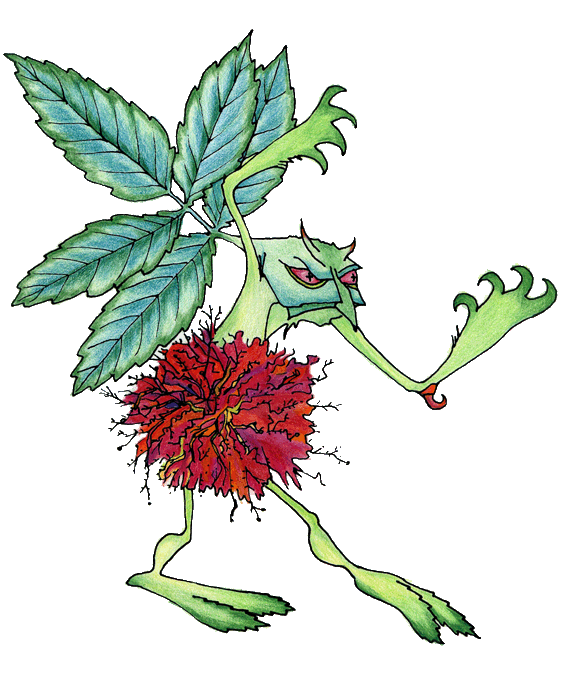| Acalitus calycophthirus ('Big bud') causes the buds of downy birch Betula pubescens and silver birch Betula pendula to enlarge and look like a huge bud that is easy to spot year round, especially in Winter. I have seen the mites in the gall in the Winter season (early Spring or late Autumn), so maybe the mites stay in the gall all Winter... The bud scales are coloured brown eventually and are hairy. According to DvL the galls can continue to grow many years, wich makes it look like the galls are growing on branches and when new galls appear they will cluster. Common species. | | 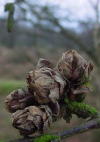 |
|
| Acalitus rudis (= Aceria) is is a mite that can often be found on Betula pendula (silver birch) and B. pubescens (downy birch). In the beginning the patches are white, but later they turn pink and brown. I have seen them on the upper side of the leaf, but usually they occur on the underside. | |  |
|
| | |
| Acalitus stenaspis causes on beach, Fagus sylvatica a very tight roll of a short to long part of the leaf edge. The roll is pale green or yellow. | |  |
|
| Aceria drabae is a mite that is most probably mainly occurring in the coastal area of the Netherlands, on Cardamine hirsuta. In the Summer and late Summer the plants can be found stunted with hardly any rozette formed, with a lilac-purple stem and distorted, rather swollen very hairy leaves. Hardly or no flowers. Seen at Schiermonikoog and Texel. | | 

|
| | |
|
Aceria erinea (= Eriophyes) On Juglans regia you can usually find Aceria erinea. These mites cause a bulge to form between veins of the upper side of the leaf and a depression on the underside. The bulges are very obvious, also because the plant cells have become extra large. The depression is covered with erineum, many little hairs, first white, pale brown later. | | 

Pictures: B. Kabbes


Pictures: J. Wolfs
|
|
Aceria genistae occurs on native broom, Cytisus scoparius. This mite causes globeshaped, witches' broom-like disformation. The buds form into a distorted mass of miniture leaves, irregular and about 5 to nearly 30 mm across. The leaves are covered with grey-brown hairs and the edges are curled upwards. Native broom does not occur everywhere and the gall may not show on every location broom is present. Jeanine Wolfs (see pictures) found the species January 2005 at Haaren, east of Tilburg. In February 2005 I noticed gall on four bushes in park Insel Hombroich, Neuss Holzheim, Germany. In 2008 I have seen them on bushes at the Hatertse Vennen, near Nijmegen. If anyone sees this species in some other place in the Netherlands (or elsewhere), please let us know! In the mean time I received many recordings of this species and it is save to say it occurs in the whole of the Netherlands. | | 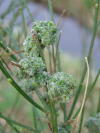
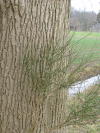
Pictures: J. Wolfs

|
|
| Aceria labiatiflorae (= origani) lives on Origanum vulgare. The leaves and flowers are malformed to grey hairy bunches, mainly at the shoot tip of the plant.. The plant is rather rare in the Netherlands and so is probably the gall. I have seen Aceria labiatiflorae in Limburg, in great numbers on the steep slopes along the rail track of the "miljoenenlijntje" in Zuid Limburg in the far south of the Netherlands.. | | 
Picture: F. Grotenhuis
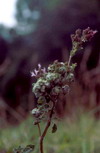
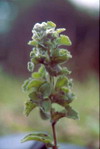
|
|
| Aceria laticincta (= Eriophyes) causes spectacular purple deformations onLysimachia vulgaris. The flowers develop to odd shapes with hairs, and never look like flowers, but more like leaves of some sort. I found a specimen at the Meinweg in Limburg in 2001 and a large group in a population of Lysimachia vulgaris in Assen in 2008. Perhaps the species is not very rare. The picture shows a specimen from Gozée, Belgium. | | )small.jpg)
Picture: J. Y. Baugnée |
|
| Aceria macrochela (= Eriophyes) is a common species of gall mite occuring on hedge maple (Acer campestre). In the angle between veins of the leaf protrude globeshaped, to 2 mm high, smooth or scarcely haired, brown to red coloured galls on top of the leaf. Underneath is the gall opening situated. The inner surface and the opening are covered with multi-celled hairs (DvL). There are usually only 8 to 10 galls on a leaf, or more or less. | | 
Picture: R.J. Koops

|
|
| Aceria macrorhyncha (= Artacris) is a very common species on Acer pseudoplatanus. Usually a group of pustules with a bight red colour are developing on the upper side of the leaf and the opening is situated below. The gall is split in two species in the UK: Aceria cephaloneus (less than 3 mm high) and A. macrorhynchus(up to 6 mm high). In the Netherlands the gall is described with different shapes and a hight between 0,25 and 3 mm. | | 

|
|
| Aceria macrorhyncha (= Artacris or Aceria aceriscampestris (Redfern et al)) lives on the leaves of Acer campestre or Field Maple and I think it is relitively rare (compared to Aceria macrochelus for example). The leaf is covered (somethimes densily) on the upperside of the leaf and on the corresponding are below with small green to red coloured pustules. | | 
Picture: T.J.M. Janson


|
| | |
|
| Aceria nalepai causes deformations and contortions in the leaves of sea buckthorn,Hippophae rhamnoides. The margins can be thickened and rolled down or upward. The galls on these photo's were seen in the Bloedbergduin at Monster. In the coastal area of the Netherlands, where sea buckthorn grows, this gall is rather common. I also saw her in Oostvoorne. | | 

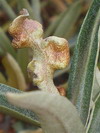
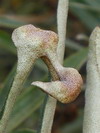 Pictures: J. Scheffers Pictures: J. Scheffers
|
|
| Aceria nervisequa lives on Fagus sylvatica (Beech). Aceria nervisequa makes the veins of the leaves of Beech show a pattern of long, white hairs. According to Docters van Leeuwen the gall has not been found since Nijmegen a 100 years ago! I first found my specimen in Glimmen, just south of Groningen, and also at the estate Bingerden, near Angerlo. Every year I found the species in places all through the Netherlands, so perhaps it is not so rare as suggested... | | 

|
|
| Aceria nervisequa is the same species as above, but it can also grow with a very different appearance. The mite can also be found underneath (usually) of the leaves of a Red Beech (Fagus sylvatica). Whole patches are covered with a pink colored carpet of hairs and it makes the whole leaf glow pink in the sun light. | |  |
| | |
|
| | |
| Aceria pseudoplatani can be found on Acer pseudoplatanus and on A. platanoides. Especially when the leave is completely covered with the mite gall the leaves can wrinkle up a little. The patches of erinea bulge out because of the tops of the erinea being thickened a little. The erinea color from white to brownish and are pink on purple-leaved varities of the maple. Possibly other species of gall mites create similar or same forms of this gall, so further research on this subject is needed. | | 


|
| | |
|
| Aceria tenella is a gall mite that induces a smooth shiny bulge on the upperside of the leaf in the angle between the main veins of Carpinus betulus (hornbeam). The hairy opening is on the underside of the leaf. | | 

underside
|
|
| Aceria tristriata is probably a recent occuring species for the Netherlands. This mite causes 1 - 2 milimeter small pustules on the leaf surface of walnut, Juglans regia. They appear to be growing mainly along the veins. The galls are bald, so there are also no hairs growing at the inside or entrance of the gall on the underside of the leaf.. So far the gall is probably only seen in the Netherlands in the province of Limburg (2009). | | 

Pictures: B. Hanssens
|
|
| Aculops macrotrichus (=Aceria) is a small red gall mite that lives in great numbers in the thickened folded veins of the leaf of Carpinus betulus (hornbeam). This growth causes wavy ridges, with the slit-like opening on the upperside of the leaf. There are often several wavy ridges present on a leaf. When trongly affected the leaf coils upwards. According to DvL the gall has been spotted several times in Zuid-Limburg, the Netherlands. The picture on the right was made on National Park Hoge Veluwe, October 2004. | | 


|
|
| Aculus anthobius (= Vasates) causes cauliflower like, spongy galls in the flowers of bedstraws. The mites are pale yellow-orange. The leaf-like flowers colour pale green, yellow, and red-purple. The whole upper part of the plant looks rather messy. In the Netherlands the gall is known for Galium mollugo, G. saxatile (on the picture) and G. verum. | | 


|
|
| Aculus craspedobius (= Aceria) creates clearly thickened upward leaf edge rolls, that are irregular and bumpy, because they are flopping down and up. The galls can be green-yellow to red and 1-2 mm wide.According to DvL they are bald, but perhaps this has to do with the species of willow. The galls can be found on Salix alba, S. fragilisand S. triandra. The example on the right is possibly a hybrid of alba and fragilis...? | | 

|
|
| Aculus hippocastani (= Vasates) is a mite causing inconspicious galls under the leaves of Aesculus hippocastanum. The galls are patches of erinea in the angle of the veins of the leaflet. The hairs are white at first and turn brown later. Common species. | | 

|
|
| Aculus tetanothrix (= Aceria) causes galls on the leaves of Salix albus that are smal (0,5 - 1 mm), round and hairy and usually colour reddish. They are situated on the upper side of the leaf, but also under the leaf. According to DvL the galls are smooth inside. The opening is oposite of the gall. | | 

|
|
| Cecidophyes galii (= Eriophyes) is a very common species of gall mite on Galium aparine. But then Galium aparine is very common!! According to DvL the mite also lives on Cruciata laevipes, Galium mollugo, G. saxatile, G. uliginosum and G. verum, but I have never seen it... The gall consists of topshoots of which the leaves have curled upwards or downwards and are twisted and curled into each other. The galls are sometimes abnormally hairy (depending on the Galium-species?!). | | 

Pictures: G.J. Branger
|
|
| Cenopalpus spinosus (= Tenuipalpus geisenheyneri) is maybe not officially a gall causing mite, although it is mentioned in Buhr as such (number 1997). It occurs atCornus mas and Cornus sanguinea. I am told it is very common. The gall is a slight upward bulge on the upperside in the angle between veins. | | 


|
|
| Colomerus (Eriophyes) vitis is every now and than noticed by people owning a grape vine (Vitis vinifera), like Mrs Ria Lemmers from Delft. On the underside of the leaf are patches of erinea visable and on the upper side of the leaf is a slight elevation of the leaf visable at every patch. The erinea (hairs) have a white colour at early summer and colour red and brown-red during late summer. According to Doctors van Leeuwen the erinea are single cellular, bending and without any branches. Usually there are several to many patches present on one leaf. Sometimes there is no elevation visible on the upper part of the leaf. In the arboretum 'De Dreijen' in Wageningen I have seen this gall mite on Vitis wilsoniae (see pictures below). | | 

 Pictures: R. Lemmers Pictures: R. Lemmers



|
|
| Eriophyes crataegi (= Aceria) grows pustules on the leaves of Crataegus monogynaen C. laevigata. The pustules are visible on bothe sides of the leaf, but the opening is situated below. According to DvL the gall mites live in the enlarged cavities of the leaf parenchym. | | 

|
|
| Eriophyes exilis (= Aceria) causes a beautiful star pattern on the leaves of Lime trees or Tilia. This pattern is especially visable on the underside of the leaf where clusters of hairs are present in the "arm pits" of side neins. The upper side of the leaf is slightly discoloured at these parts and is a little bit swollen to a dome (and can smetimes be hairy). The opening is situated on the underside. According to DvL the inner parts of the galls are lined with unicellular hairs. Locally common. | | 



|
|
| Eriophyes laevis f. alniincanae occurs on Alnus incana in Scandinavia. So far I have seen this species in Norway and Finland. The galls are very similar to Eriophyes laevison Alnus glutinosa, but they are often more abundant on one every leaf and are more pinkish and often hairy. | | 
Picture: Roelof Bijkerk
|
|
| Eriophyes leiosoma causes the growth of hairy patches on the bottom side of the leaves of Tilia species (Lime tree), but also hairy deformations on the sepals and other flowering parts. The edges of the sepals curl to both sides along the length direction, first covered with white and later with brown erinea (hairs). The mites have a brown-pinkish appearance and can be admired in great numbers when the erinea have turned brown. | | 


|
|
| Eriophyes prunispinosae is common on blackthorn (Prunus spinosa) and usually causes deformations on the leaf edge, but sometimes also on the leaf blade. they are pouch-like pustules that can be roud od elongated. The galls are usually light-pink and hairy and have an opening on the upper surface of the leaf. | | 
Picture: G.J. Branger


|
|
Eriophyes tiliae (= Phytoptus) is common on Tilia platyphyllos and looks like two drops of water to the species mentioned below. The galls are like a tall, cone shaped pouch, often taller than 8 mm, uaually colouring red. The galls vary in shape and degree of hairyness. The opening is situated on the other side, with white erinea. According to DvL the gall cavity is lined with long, cilmdrical hairs, tapering to the tip. The difference with the next species is the hight and also tilae is supposed to end with a pointy tip where lateannulatus is supposed to end with a rounded tip. It would be nice to see this confirmed in NL as well. Eriophyes lateannulatus (= Aceria) causes galls that are like the previous species, but than on Tilia cordata. According to Redfern et al (2002) the galls are about 5 mm hoog. Both species use (according to Redfern et al (2002)) the hybrid of both tree species: T. x europaea.
| | 
Foto: R.J. Koops



|
|
| Phyllocoptes eupadi (= Eriophyes padi) is a mite that causes rather large pillars on the upper part of the leaves of Prunus padus. The shape varies, but the colour usually becomes somewhat pink or red. The leaves can be so densely covered with galls that the leave gets deformed and wrinkled. | |  |
|
| Phyllocoptes (Eriophyes) goniothorax is a gall mite on hawthorn (Crataegus monogyna) that rols the edges of the leaves. The rolled edges become slightly thickened and colour yellow and red when older. The mite also occurs on the underside of the leaf. Hairy patches appear that are purple-red to white in colour. | |  |
|
Phytoptus avellanae (= Eriophyes) is a big bud gall on hazel, Corylus avellana. Very common and easy to spot because of its enlarged, nearly globular buds. The buds can grow to about 8 mm. The gall consists of many undeveloped thickened leaves. The inner side of the little leaves are covered with small green growths.
Phytoptus avellanae can also be found on Corylus colurna. The galls on C. colurna are at least twice as large as usual. | | 
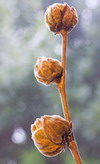
on Turkisch hazel
Pictures: E. van den Ham

op een rode gewone hazelaar
|
|
| Stenacis euonymi is a just discovered (2008) species (for the Netherlands) on spindle,Euonymus europaeus. The margins of the leaves are curled upward in a tight roll and slightly thickened. The galls are pale green or pink to reddish. Mites live inside. | | 
Picture: F. Grotenhuis
|
|
| Stenacis triradiatus (= Eriophyes) lives on Salix alba, S. fragilis and S. triandra, but I have also seen this gall in abundance on a bush that looked a lot like Salix aurita,in the Berggarten in Hannover. In the Netherlands I have seen the gall on all three first mentioned species. Depending on the place on the plant where the gal is developing it has lots or no hairs and the shape is very variable (5 - 40 cm). The galls can grow from the catkins or from the buds, but they all result in a witches broom kind of gall. Usually the galls are only present on one willow tree in the area and all its collaegues are free from this mite. Although Stenacis triradiatus is found in the galls in great numbers it is not clear if they actually induce the galls, because it could also have a mechanical origin or the gall is induced by ten of the other eriophyoid mite species that are found in these galls. It is possible these mites are only inquilines. | | 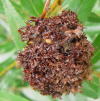
Picture: J.W. Wertwijn


|
|
| Trisetacus juniperinus is a mite on Juniperus communis. The leaves are placed very close together and deformed to a round shape resembling the fruit of juniper, although they are slighty smaller and more irrregular. Where the points of the needles meet, at the bottom of one side of the gall, is the small opening situated. Within live many red orangge coloured mites. | | 

|
|
| Trisetacus pini causes cancer like galls on the branches of pine, Pinus sylvestris.According to DvL this gall also occurs on P. mugo. The swellings start usually on one side of the branch. They have a irragular shape that is mostly round or oval, with at first a smooth surface and later rough. Its size can be a little more than a centimeter. In the many hallways thye mites live. The gall can keep growing for several years. She is probably not very common. | |  |
|
| Trisetacus quadrisetus causes galls in the fruit of juniper, Juniperus communis. The berry is slightly swollen and the three scales are not entirely merged, so that some extra space is visible at the top of the fruit. Inside live many red orange coloured mites. | | 


|
| | | |
 Nederlands
Nederlands
